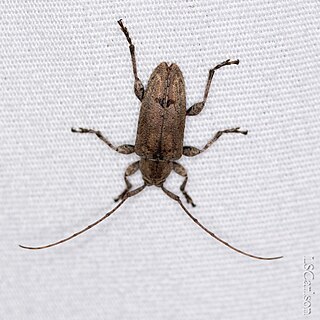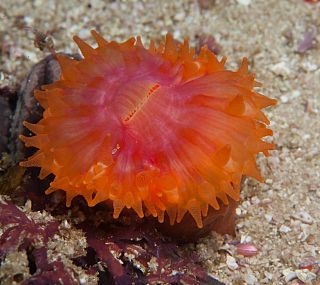
The whistling ducks or tree ducks are a subfamily, Dendrocygninae, of the duck, goose and swan family of birds, Anatidae. In other taxonomic schemes, they are considered a separate family, Dendrocygnidae. Some taxonomists list only one genus, Dendrocygna, which contains eight living species, and one undescribed extinct species from Aitutaki of the Cook Islands, but other taxonomists also list the white-backed duck under the subfamily.

The wandering whistling duck is a species of whistling duck. They inhabit tropical and subtropical Australia, the Philippines, Borneo, Indonesia, Papua New Guinea and the Pacific Islands.

The barred fruiteater is a species of bird in the family Cotingidae, found in Bolivia, Colombia, Ecuador, Peru, and Venezuela. Its natural habitat is subtropical or tropical moist montane forests. The population is stable, and they are considered common.
Pauridiantha arcuata, synonym Stelechantha arcuata, is a species of plant in the family Rubiaceae. It is endemic to Cameroon. Its natural habitat is subtropical or tropical moist lowland forests. It is threatened by habitat loss.

Evarcha arcuata is a species of jumping spiders with a palearctic distribution.

Corythucha arcuata, the oak lace bug, is a species of Tingidae that is a pest of oaks. It is native to the New World, and was first observed in Europe in 2000.

Conasprella arcuata, common name the arched cone, is a species of sea snail, a marine gastropod mollusk in the family Conidae, the cone snails and their allies.

Drepana arcuata, the arched hooktip or masked birch caterpillar, is a moth of the family Drepanidae. The species was first described by Francis Walker in 1855. It is found from Newfoundland to Vancouver Island, south to at least North Carolina, South Carolina and California.
Simnia arcuata, common name Vidler's simnia, is a species of sea snail, a marine gastropod mollusk in the family Ovulidae, the ovulids, cowry allies or false cowries.

Cassinia arcuata, commonly known as drooping cassinia, biddy bush, Chinese scrub, sifton bush and Chinese shrub, is a species of flowering plant in the family Asteraceae and is endemic to Australia. It is a shrub, sometimes a small tree with sessile, linear leaves, and heads of up to two hundred brownish flowers arranged in pyramid-shaped panicles. In New South Wales, the species is known as Cassinia sifton. In disturbed areas, C. arcuata can become weedy.

Astylopsis collaris is a species of longhorn beetles of the subfamily Lamiinae. It was described by Haldeman in 1847.

Astylopsis macula is a species of longhorn beetles of the subfamily Lamiinae. It was described by Say in 1826.

Astylopsis perplexa is a species of longhorn beetles of the subfamily Lamiinae. It was described by Haldeman in 1847.
Astylopsis sexguttata is a species of longhorn beetles of the subfamily Lamiinae. It was described by Say in 1826.

Necroraphidia is an extinct genus of snakefly in the family Mesoraphidiidae. The genus is solely known from Early Cretaceous, Albian age, fossil amber found in Spain. Currently the genus comprises a single species, Necroraphidia arcuata.

Caryophyllia is a genus of solitary corals in the family Caryophylliidae. Members of this genus are azooxanthellate and are found in the North Atlantic Ocean and the Mediterranean Sea at depths down to 2,670 metres (8,760 ft).

Asura arcuata is a moth of the family Erebidae. It was described by Frederic Moore in 1882. It is found in India, Indonesia, Taiwan and Japan.

Luzula arcuata is a species of flowering plant in the rush family Juncaceae with the modern common name curved wood-rush. The plant is native to mountains of northern Europe, north-western and north-eastern Asia and north-western North America.

Calamovilfa arcuata, commonly known as Cumberland sandreed, is a species of flowering plant in the grass family. It is native to the southeastern United States, where it is found in river scour zones. Due to its specialized habitat, it has a highly localized range, found only on the Cumberland Plateau and in the Ouachita Mountains.

Macracantha is a genus of Asian orb-weaver spiders recognized as containing the species, Macracantha arcuata., although some schemes also recognise inclusion of Gasteracantha hasselti in this genus. Macracantha is notable for the extremely long, curved spines on the abdomens of female members of the genus; Eugène Simon created the taxon name from the Greek words μακρός and ἄκανθα (spine). It occurs from India and China through Southeast Asia to Indonesia.

















